Why Altruism Is The Ace To Get Your Dream Design Job
Hunting for a design job can be daunting but it does not need to be. In fact, the most telling predictor of how user-focused a designer you are, is how you see the company you apply to.
In this article, I’d like to outlines uncommon tactics and crucial aspects that can help any designer. In order to get your dream job, I’ll discuss in detail on how to plan and execute your outreach to recruiters or hiring managers. Writing a stellar CV by analyzing job descriptions or calculating how many applications you have to send are just some of the aces in your pocket.
The Biggest Issue In Job Hunting
The cover letter below is the worst application we have received in years. It lacked everything you may be looking for in an application. Apart from neither an introduction nor a name, it tells the story about “me, me, me” at its best, unfortunately. And unsurprisingly, the “portfolio” did not match either.

I did hunt for a job myself in the past, of course. But since running blended.io for a few years now, I can tell that the attitude of “me, me, me” does not fly well. It is the biggest issue that prevents people from getting their dream job.
Can you see why? Imagine that you hire a painter to paint your living room. The painter comes by, does not listen to you and then paints the room in a color that he/she likes — not what you want. You hired a painter to paint the room in your favorite color, right?
Fundamentally, designers like to see themselves as the voice of the user. Designers solve user problems, don’t they?
Interestingly, that user-driven attitude turns into plain selfishness when designers start to look for a new job. Many want to solve their need only. Obviously, the company wants to hire someone to solve a problem they have internally. Henceforth, any designer who does not realize that the company one applies to is actually the user in question, should not be in (user-centered) design to start with.

When you look for a job, you may ask yourself:
- Can I do interesting work?
- Will I get along well with the coworkers?
- Do they pay well?
Companies, on the other hand, ask themselves:
- How much experience does s/he have?
- Will s/he fit well?
- Do we get extra value for what we have to pay?
See the problem? There is a clear gap. You may now say that the company is mainly focused on their problem, that is, matching a candidate with their internal need. Indeed, they are. Does a user for whom you are designing care about who designed the product? No.
By now you should be able to see why “Me, Me, Me” is such a big problem. An application that screams “Me, Me, Me” plainly shows the company that the applicant’s sole purpose is to look after her- or himself. For context, would you buy stuff you really don’t need? No. Alas, why shall the company hire someone they don’t need? In terms of UX or design in general, the most telling predictor of how user-focused you are is how you see the company you apply to.
When I started to write this article, I spoke with a friend of mine. Let’s call him Mark. Mark told me that he was on the lookout for a new job and that the process was going OK. I urged him to review his approach and cover letter regarding “Me, Me, Me.” The following day he changed the email and cover letter he had wanted to send and turned “Me, Me, Me” into “How can I help you achieve your goals?” Guess what? He was invited for an interview.
Of course, I cannot fully tell whether it was the change in approach or his strong portfolio, or something else. It may well have been the case. Though, I find it interesting that he was invited the next day.
Actual Applications, Real Insight
In the past, we’ve recruited designers and engineers for our innovation agency. After some time, you can see patterns emerging. To notice the subtleties of these patterns, we will review job applications that we have received.
The following are actual applications for a position as Software Engineer (NodeJS). These below are not handpicked but rather a somewhat random selection.
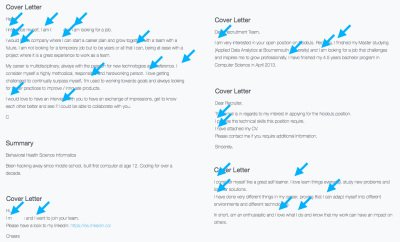
Let’s review the main points we notice from these applications above:
- Around 80% of cover letters start with “Dear recruiter” or similar, not addressing a specific person. Why does this matter? We are not 100 people at our company. The applicant does not show interest as she did not bother to look up the person who could be in charge.
- The majority of applicants start many of their sentences with something like “I can, I want, I will.” Why does this matter? When you design a product, who do you design for? Exactly, the user. As we pointed out above, the user is the company to which one applies.
As this is an article for designers, we will also review applications for a design role. After we received an application for an Interaction Designer, we sent out additional questions to the applicants to better understand their background.
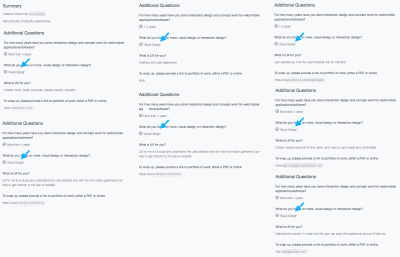
The form we sent out included a question about their past work and experience. As it turned out, many applicants sent very similar answers to the ones you see on the image above. The most interesting: On the question what the applicant focuses on most, almost everyone responded with “Visual design.” Keep in mind that the role advertised was for an Interaction Designer vacancy. I cannot tell whether it was clear to applicants what interaction design implies, but why would they apply if they don’t understand the role’s responsibilities?
Remember what I explained above? An applicant focused on the user (that is, the company in question) should realize that such replies do not match the requirements (the need) and will not make the cut. The best indication of the actual problem company X has is the job itself. Unless you know someone at that company, the best starting point are the nuances of job descriptions.
In the next section, we will review how to read job descriptions and how to best prepare your CV, resume or portfolio. Further, to show you hands-on examples of what kind of cover letters we really liked, you will find two examples at the end of this article.
How To Read Job Descriptions
I am not a person who ever worked in the recruitment industry per se, nor do I recruit 8 hours per day. I will cover the most important aspects seen from my perspective.
A Cover Letter — Again?
Imagine a funnel that has five steps and only allows items with a certain property to pass each step. The cover letter is part of the first step. It segments those out who are not willing to take the effort and tell why they are interested. For context, Imagine a pay-to-play game with a certain economic benefit for the winner. You would not pay up for a game if you would not think that you could win, right? Same with the cover letter. The effort you put in is the upfront payment.
We, as the hiring company, look for a match to the role we want to fill. Sounds obvious I would say. Nonetheless, we receive applications that just do not match up. The reason is twofold: First and foremost, the experience, value, and skills often don’t match. Second, if an applicant does not send a proper introduction, resume or portfolio, how can we tell whether experience and skill set match?
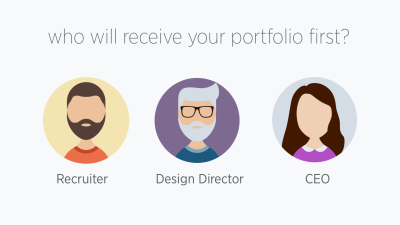
Who Is The Addressee?
We talked about that the company you apply to equals the user you would design for, but there is a more nuanced perspective to this. If you consider a typical company, how many people would look at your application and in what order?
- A recruiter or HR person;
- The domain expert, e.g. Senior Designer or Design Director;
- The CEO or department head;
- Others.
To whom are you about to send the initial application? Very often that person is a recruiter. What is their expertise, UX or recruitment? Exactly. Be aware who will see your portfolio first and consider what the receivers expertise is. In our case, we don’t have a full-time recruiter on staff. Therefore, an application is likely to arrive in my inbox.
A report by The Ladders indicates that recruiters spend about 4-5 minutes per resume (self-reported data). The actual study though finds that recruiters spend 6 seconds reviewing an individual resume! I assume the reason is to some extent that they just get so many resumes. Why do they get so many? Well, I think that this, in turn, is due to fact that people apply at way too many jobs that do not match. Mind that the study does not indicate in what industry the recruiters work. Interesting to note is that the study also suggests that standardly formatted resumes reduce cognitive load and are easier to read (hard to tell whether that has equal weight in the design industry).
A recruiter, in most cases, cannot tell whether your portfolio work is stellar or not, nor do they aspire to. Recruiters manage the process from start to finish. They start with an apparently short review of your resume or CV. They look for matches between role and resume: the better your resume matches the job description, the higher your chances.
You have two options: Pick jobs that match your resume, or prepare the resume so that it matches the job description. The former is certainly less work and yields the best results in my experience.
Quick Portfolio How-To
But what about your portfolio? It’s pretty much the same thing. Everyone unconsciously understands that. Why would you send an application for a visual design role when you are a user researcher? Still, some people do for reasons I cannot understand. Aren’t we in the business of solving user problems? Who are the users and what are their problems?
Moreover, a recruiter is a human being. What does a human being without domain expertise perceive when they review portfolios? Visuals, of course (even if unconsciously). Everyone can tell whether some work or a portfolio looks properly done or not. Therefore, make sure to include great visuals even if you apply to non-visual design roles, for example. If you are not great with visuals, browse around and look for portfolios you like and then mimic what you see.
On the other hand, the domain expert might see your portfolio first. In such a case, get right to the point. Neat visuals are always a good idea because they also tell the viewer that you know how to structure the content for communication purposes. Don’t get me wrong, content matters most. You need to be able to get the right message across that is catered to the job in question.
If you are about to re-do your portfolio or just want to improve it, look for your dream job and its description for clues. Ideally, gather a bunch of them and then compare. Create a checklist of important needs and requirements across jobs you’ve found. Based on the checklist, start to structure content to build up your portfolio as best possible. Then take a step back and see how you can design the content to that it tells the story. That process can be the sure-fire way to get your application past recruiters and into the hands of the decision maker.
The Market Drives Everything
I once read an article from a founder who had just raised funding. He wrote about his experience interacting with CVs and wrote:
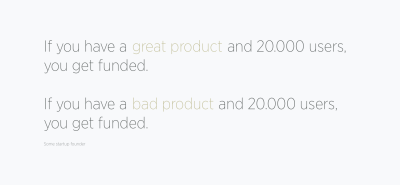
Why is that? As far as I know, no fundamental law of nature exists that a product has to be great (leaving aside the subjective meaning of 'great').
The reason is that a customer uses a product not because it’s “great” but because it solves their problem (similarly with a new hire). I would even argue that the market drives (almost) everything. For example, a funded company can hire more people faster.
Why does it matter you wonder? I am not suggesting to have a less than stellar design portfolio nor bad code. You don’t know with whom you are in competition with for a role at company X. So, I urge you to consider the dynamics and the strength of the market or opportunity (the company pursues) for which you indirectly sign up for (in case you get the job).
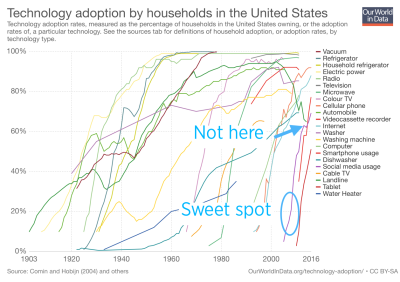
First, pick companies that solve real user problems. Remember MySpace and Twitter in the early days? Their web and mobile experience were way less than stellar but users did not care. On the flip side, companies that do not solve real problems will fade and vanish. Along the slow decline, raising that next round of funding will be tougher, team morale will turn sour, employees can feel that product stickiness will just not happen.
Second, use market dynamics to your advantage. Consider applying at a company that is pursuing an opportunity in new markets (for in-house positions generally). In regard to a design studio or agency, this would imply that the studio itself has positioned itself as a firm that helps companies in new markets. Remember that to a huge extent the market drives the success of that studio, not because they have such a great process.
A company without an in-house designer or design team might be on the lookup for such a person. Look for the sweet spot. That is, a market that is in its infancy, e.g. blockchain, VR, unmanned travel. Of course though, those companies are harder to spot and riskier than established ones.
Markets that are not yet mainstream are not sexy to the early-to-late majority crowd. The result is such that vacancies at companies in unknown markets do not have as much competition (around 1896 in the chart).
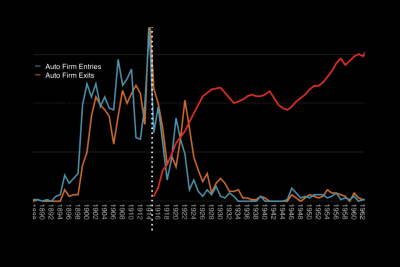
Third, a result of the above is that older markets consist of only a handful of established companies (around 1935 in the chart). These are the ones that were and are strong enough to fight and win the battle of competition. These companies are established, hence, competition for jobs is fierce.
One last thing I’d like to point out concerning the market: Go where the action is (i.e. “Go where the puck will be, not where it is right now”). If you are into Fintech, go to Frankfurt, London or NYC. Into movies? Go to Los Angeles or Munich. And most importantly, go where the clients are.
Some may argue that with chat and video conferencing tools, does it matter whether the competition is in Berlin or atop a mountain in Switzerland? I would argue that it does. As a local, serendipity will also come to your advantage (tough to mimic that as a remote freelancer). Being able to go out and network offline (in hubs like Berlin), gives you a competitive edge over the myriad of freelancers in Bali.
“Hello, I Am Awesome”
Know where you stand and know what matters where you want to go. This is crucial and saves you a look of effort, hassle, and pain.
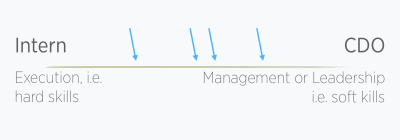
For example, for a young designer who is about to start her career, hard skills matter. The higher she advances in her career, the importance of hard skills will decrease and that of soft skills will increase, e.g. taking things less personal, leading teams, being able to resolve conflicts, giving sincere feedback and productive criticism, and the like.
How Do You Know Where You Stand? Ask!
Last weekend, a colleague of mine whom I had met six months ago for the first time, asked me to touch base with him. He wanted to talk about his portfolio and how it could improve. He wanted to know where he stands.
Ask more senior people in your current company for feedback. Reach out to colleagues of colleagues or friends that are more senior and in the same industry as you. And then, do not ask for hard skills only — also inquire about your soft skills. Apart from getting feedback for you to act on, the kind of inquiry also shows that you are humble and open for feedback.
Ask feedback about what you do not so well. Be persistent. People have learned from experience that their counterparts don’t like to receive negative feedback. So, you have to push to elicit this kind.
The earlier you are aware of such behavioral pitfalls, the better it will be for you. I have learned that the hard way myself. Not that I was not asking about soft skills but rather that when I made mistake here and there, people hardly ever told me. So when I asked people, they told me (if they had experienced anything, of course).
I Am Awesome. Of Course.
Be aware that practically everyone says the same about themselves: I am awesome. Although cover letters are not 100% the same, of course, they very much rhyme in many aspects. The majority of people think that they do great work, they want to learn, grow and join a great company.
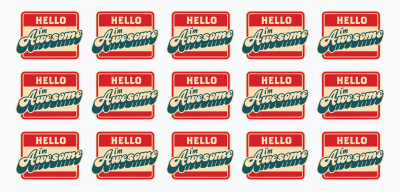
So, How Do You Distinguish Yourself?
Do not tell, but show! And don’t talk about what you want but how you could help.
In terms of UX or design in general, recruiters expect a portfolio. But then again, every designer does have a “great” portfolio of some sort. Now what? This is how you can distinguish yourself further:
- Organize or speak
This extends your network and makes your name known across borders. - Write
Like what I'm doing here. - Volunteer
At a conference, for example. - Go the extra mile
See the points above; go to meetups after work, ask the hard questions, ask peers how you can improve, follow up after rejections (this is a hard one, I know, but how could you get feedback otherwise?) - Network frequently
Too often, this is underestimated.
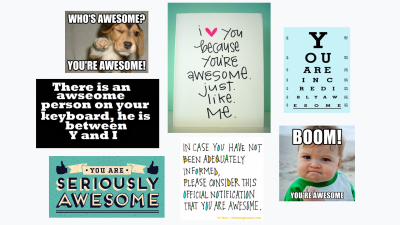
These activities show — and this is most important for a recruiter/company — that you are interested in a topic above your day job (that pays the bills). This is hardly new, but why does this work?
Companies want to get a good deal, and receive extra value for free (everyone wants to have something for free, right). What is a good deal? A good deal is either very cheap in economic terms or adds value on top (that comes for free). Companies do perceive the aforementioned activities as added value. For example, a colleague of mine runs a design company in Munich. One of his employees is part of a jury of a well-known design prize in Germany. The company perceives this as added value (e.g. they can use it for ads, and this promotes their business indirectly).
Networking: How I Received 35 Introductions
Networking is important, everybody understands that. And this is where it ends. You may also understand that you have to give first and don’t expect anything in return, immediately. Sounds easy but isn’t. It is effort, unfortunately.
A good colleague of mine, Tony, told me years ago that you have to build your network when you do not need it. As Stephen Covey said some time ago, “Always start with the end in mind.” In order to show you (remember, “Don’t tell”) how that worked for me, here is a short job hunting story.
35 Introductions In Two Weeks
I spent a couple of weeks in San Francisco in March of 2011 (for context: I am originally from Germany, where I have spent about 50% of my career, and currently reside in Berlin). While there, I networked as best as possible, collecting as many contacts as I could and made sense. I already had a network in California because I had lived in Los Angeles back in 2006.
I decided to make a return trip to San Francisco in September to hunt for a job. Prior to my trip, I reached out to the connections I had made in March as well as any other friends and colleagues already in my network.
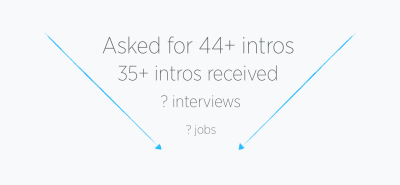
In total, I had asked about 44+ people for an introduction to colleagues in their network. Most of those 44+ were acquaintances, though a handful I knew better. Up until the first week in September, I had received 35 introductions (thanks again if you, dear reader, had been one of them).
A couple of things that are noteworthy: First, I did not know these 44+ people well. In most cases, I did not give first, that is, I did not ask how I could help before asking for help myself. However, I did earnestly convey that I would go to length to reciprocate the favor. What made the difference for me was that I was persistent. I tracked each conversation or request for an introduction and followed up if I had not gotten an intro, a reply or else.
Out of those 35, I managed to get 5 interviews at the likes of Amazon, Grockit, and Evernote. I did not manage to get a job at the time because the H1B visa quota filled up fast and unexpectedly in mid-September. This left me practically without a chance to get a visa (before even having had all interviews).
Here is what I do when I meet new people: I write down their full name, email and/or phone number. I make a note about what the person does and what we had talked about. I add a note like “May 18, 2018, what does the person do, where does s/he live”, and who did the introduction.
Furthermore, I try to find out what the person needs or wants to achieve and then offer to put them in touch with someone in my network. What generally helps tremendously is to have a good long-term memory of people and their needs, and the desire to help. Lastly, I connect on LinkedIn in order to stay up to date about what colleagues do and need.
Don’t Forget: Give first and don’t expect anything in return.
From Opportunities To Job Offers
Get yourself a neat Kanban board (a set of columns where tasks move from left to right) with Trello or Asana, for example (any board suffices). There is really no excuse anymore for anyone to not be able to track each introduction, job position or next action.

Set up four columns and name them as the following:
- Opportunities
- Introductions
- Application sent
- Interviews/Offers
Opportunities
All opportunities go here, whether you found a vacancy online or were told by a friend to have a look at a company.
Introductions
The name says it all. For each vacancy that interests you, research whether you know someone or whether a colleague/friend of yours knows a person at the company. Once you’ve found a connection, kindly ask for an introduction. Keep in mind that an introduction usually will take at least a week. Beware that some people may not even know a person in question. Thus, send +1 requests for introductions.
Asking For An Introduction
Do not send a simple email such as “Please introduce me to XYZ”. In order to increase your chances, write a template like the following.
Your email template:
Hi %friend%,
I saw on %socialNetworkName% that you are connected with %personAtCompany% at %company%. They have an interesting vacancy outstanding to which I’d love to apply. I would like to ask whether you would mind introducing me to %personAtCompany% (if you know the person well enough)?
To make it easy for you, I have prepared an email for you to copy and paste. In the meantime, how can I help you?
Thanks in advance,
Bye, %yourName%
PS: In case that you don’t know the person well, please let me know. Thanks.
Subject: Intro %personAtCompany% <> %yourName%
Hi %personAtCompany%,
I would like to introduce you to %yourName%. S/he saw an interesting vacancy at your company. S/he is CC’ed. I will let her/him reach out to you directly if you don’t mind.
Hope that I was able to make a worthwhile introduction.
Bye, %friend%
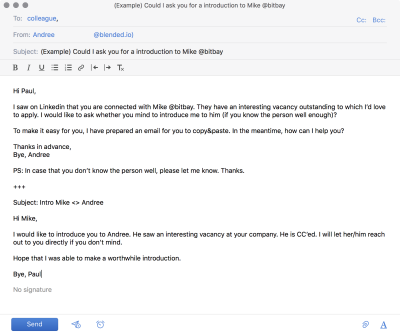
Application Sent
Once you receive an introduction, send your application as soon as possible AND thank your friend with a quick email. Then move the card/opportunity to the “Application Sent” column and set a date/note on it to follow up in one or two weeks.
Pro tips: See section “How To Apply” further down.
Interviews (Offers)
In practice, this column will have much fewer cards. For this reason, I put this together with Offers. Eventually, you may take one of the first offers and don’t need the Offers column anyway.
Pro tip #1: Set aside a time in your calendar to go through each column and follow-up task.
Pro tip #2: Whenever you are in touch with a person at the company, make sure to add her/him to your contact list, together with a couple of notes. If you have had more frequent interactions, feel free to connect on LinkedIn. Why? People move around companies and you never know when you may meet again.
The Math Of Job Hunting
What is your ratio of job offers to applications?
Don’t know? Well, the ratio will tell you how long you will likely be looking for a job.
It is a tough question to answer. The problem for most of us though is likely to be overconfident. We all like to see ourselves as one of the lucky few who get a decent job almost immediately. Apparently, the math doesn’t prove that assumption.
The data I was able to find in regard to the number of applicants per position is very broad. Some sources report that they receive 250 applicants per job opening, others report around 60 (data from 2014). Though, the probability that the applicant will take the offer seems to be around 89%.
Let’s take these number as the upper and lower bounds. Alas, your ratio may be between 1:60 and 1:250. Whoa! That means that you need to send out between 60 and 250 applications to get 1 job offer.

Taking the above numbers into consideration, the main question becomes how productive you really are, i.e. how many applications do you send out per week? Let’s start with 2 per week and run the numbers.
- A ratio of 1:10 would imply that with sending 2 applications per week, it will take you 1.15 months to get an offer (10/4.33/2 = 1.15).
- 1:60: Sending 2 applications/week, it will take you 6.93 months.
- 1:250: Sending 2 applications/week, it will take you 28.87 months.
If you send out 2 applications per week, it will take you between 7 months and 2+ years to find a cool job. Gosh, that is a long time indeed. Alas, 2 per week doesn’t get you anywhere (unless you are one of the few).
But what about 10 applications per week?
- 1:60: 10 applications/week, results in a job hunt that takes 1.39 months,
- 1:250: Sending 2 applications/week, it will take you 5.77 months.
That looks much better (on first glance). Of course, sending out 10 resumes per week also implies that you have to find 10 suitable openings per week, preparing resumes and portfolio, email and cover letter, and so on.
That is decent effort. Whatever way you cut it, that is the math. Now the question is what ratio does apply to you? I strongly suggest starting with something like 1:70 (8 months for 2 applications/week or 1.6 months for 10/week). Why? Because it will instill the right motivation right at the get-go.
But here is another aspect. If you consciously search and separate the OK from the ‘Awesome’ (those that almost perfectly match your experience) jobs you find, your ratio increases. The better the match, the better your chances are. If, say, the ratio doubles to 1:35, it may just take 3–4 weeks to get this awesome job (10 applications/week). Focus and deliver for 3–4 weeks, and done!
How To Apply
In short:
- Always ask for an intro first (see above how to do this);
- Reply within 1-2 days if you have gotten the intro (attach e.g. CV);
- Follow up a week later;
- Follow up each week until you get a response.
If you do not know anyone that could connect you to the company, test the waters (not the best approach). This is why networking is so important. The more people you know, the more likely it is that you can ask someone for an introduction. The spoiler: please do not randomly invite strangers on LinkedIn. Although it does increase your reach, it won’t work well.
But here is your real edge by following the process: 99.5% (gut feel) of applicants do not get past step 2. They do not follow up.
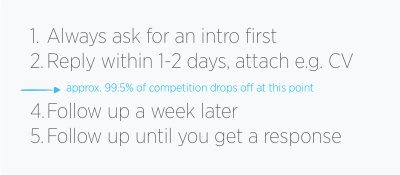
Follow Up Or Die
I mean it. If you have a good task list or Kanban-like board with columns at your disposal, this will get much much easier. If you receive a rejection, take it as a learning experience. Always ask for feedback. Without feedback, you cannot grow. When you follow up, do this:
- Reply and be kind;
- Make it easy for the other person to say “No”;
- Make it clear that your intention is to get feedback to be able to learn, improve and grow.
Crucial Notes:
- Follow up until you get a reply that is to your liking. I can already see your face: “I only get general HR emails.” Very often yes, but have you ever tried to follow up more than twice?
- Be aware that companies or recruiters may not want to go into detail by email because of legal reasons. It might be worth suggesting to talk on the phone or meet face-to-face instead.
Examples Of Good Cover Letters
As I mentioned above, here are two cover letters for an interaction design role that we really liked. See the difference to those applications at the beginning?
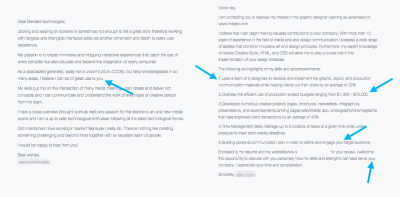
Putting It All Together
You might remember the very first sentence of this post: Finding the right job that excites, challenges, and paves the way for a long-term and evolving design career is hard work.
The approach with the least effort is to send out a whole bunch of automated emails and CVs no matter what the job asks for. By following this approach, you would indeed consider the math of job hunting. But that’s about it. The downside is that you would need to factor in the worst ratio you are willing to accept: 1:250 but perhaps 1:300 or more.
For a moment now, consider the company who accepts an applicant with such an approach. Do they know what they are doing? Alas, when you consider the above, there is hardly another way for your new and exciting dream job: hard work. Luckily, you can plan ahead by using the math of job hunting to your advantage.
Although this article is hardly a complete 101 of job hunting, I tried to make you think out-of-the-box in regard to some crucial aspects that, in fact, few people consider. Now it’s your time to take action: Pick an aspect from above that you have not considered yet and apply the learnings to make you stand out.
Always remember that the most telling predictor of how user-focused a designer you are, is how you see the company you apply to: the company is the user.
Further Reading
- Mobile Accessibility Barriers For Assistive Technology Users
- Frequently Heard In My Beginning Front-End Web Development Class
- A Web Designer’s Accessibility Advocacy Toolkit
- Recovering Deleted Files From Your Git Working Tree



 SurveyJS: White-Label Survey Solution for Your JS App
SurveyJS: White-Label Survey Solution for Your JS App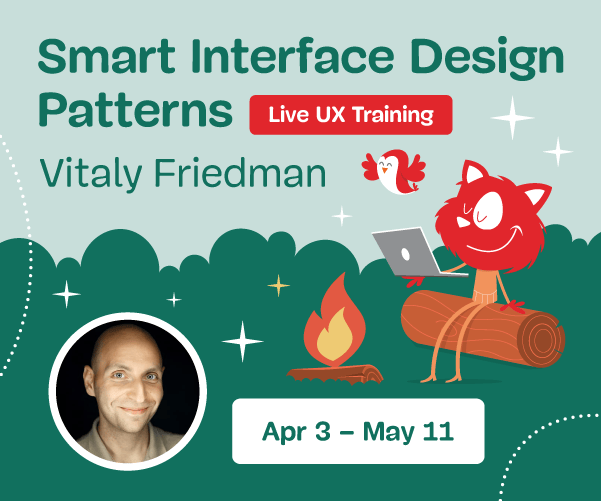

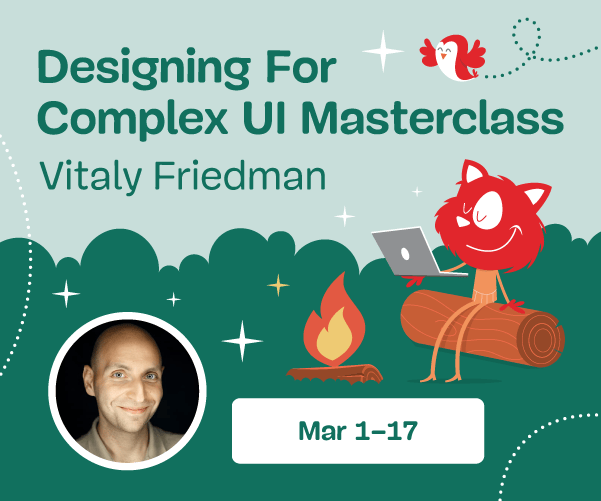
 Agent Ready is the new Headless
Agent Ready is the new Headless

